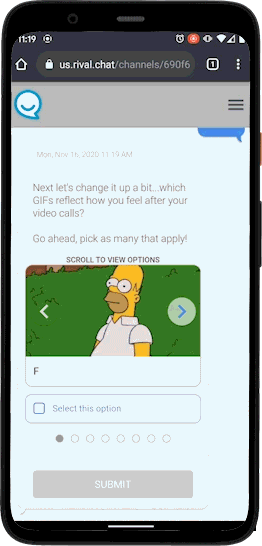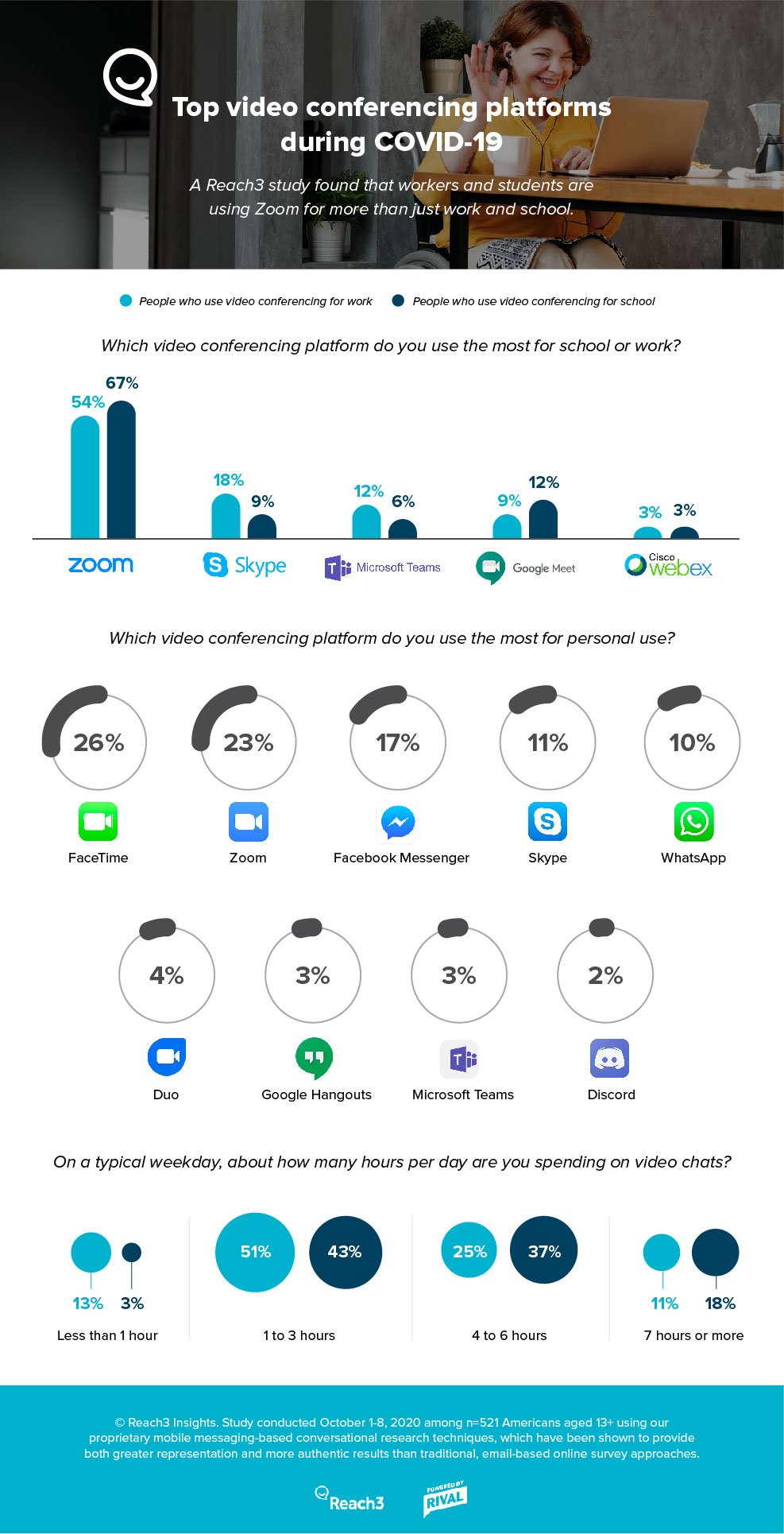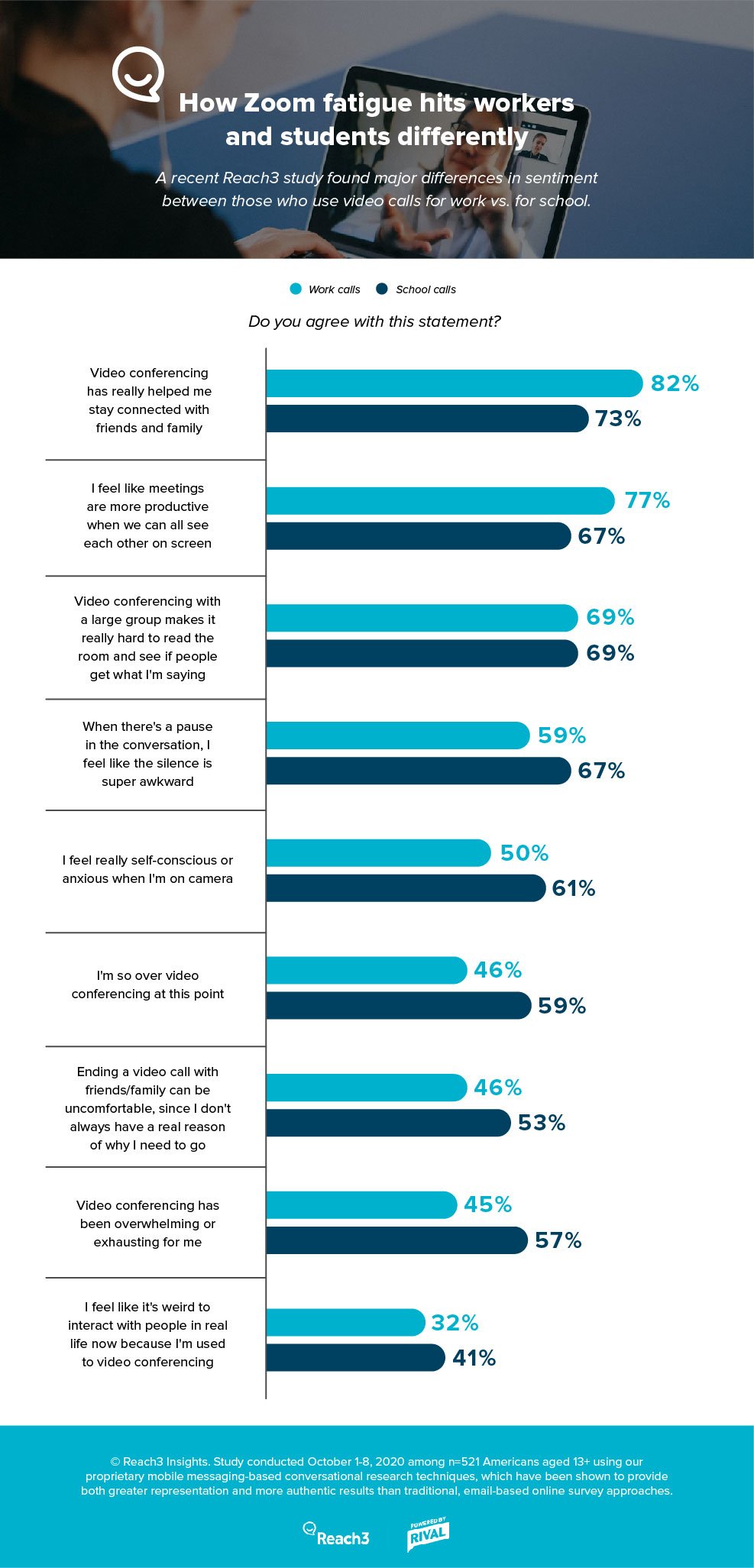57% of those who use video calls for school find themselves overwhelmed or exhausted by video calls, while only 45% of workers feel the same way
With 2020 winding down, it’s worth taking a look back at how COVID-19 has forced us to take our work, learning, and socializing to virtual video calls. The biggest winners have been the video conferencing companies, with Zoom stocks up 600% this year as of end of October. Microsoft (which owns Skype and Microsoft Teams) posted an eye-popping $14 billion profit in its latest quarterly results.
But eight months into quarantine with an end still not in full sight, there’s still a lot of unknowns about how all these video calls have impacted us. How are users adjusting to doing their work online? With the school year wrapping up in a couple weeks for many colleges, how have students fared with online learning? Is Zoom fatigue as bad as we think? If so, who is most susceptible to it—and what can tech companies, educational institutions and employers do to help combat it?
 At Reach3, we work with many tech companies that offer video conferencing solutions to employers, schools, and other organizations. To help our clients navigate shifting user behaviors and attitudes around video chats, we used Rival’s market research platform to engage 521 Americans about the topic in October 2020.
At Reach3, we work with many tech companies that offer video conferencing solutions to employers, schools, and other organizations. To help our clients navigate shifting user behaviors and attitudes around video chats, we used Rival’s market research platform to engage 521 Americans about the topic in October 2020.
Through our conversational, mobile messaging-based approach, we uncovered insights on the current state of video conferencing and where tech companies can innovate. An interactive mobile deliverable is available, but we've also shared some key takeaways below.
Everyone is zooming
While it was already growing in popularity before 2020, Zoom has quickly become synonymous with video conferencing in the past year. Zoom is the dominant player for work and school calls, but, surprisingly, it is also becoming popular for personal use.
There isn’t a clear market leader yet in the personal video call space, but Zoom is already among the top services there. Along with name recognition, company “Zoom happy hours” proved Zoom’s use case for personal events early in the pandemic. Adding features like filters and virtual backgrounds help bring the fun, while functional features like breakout rooms and polls can be used to run virtual trivia.

Zoom fatigue is a real thing
Since the start of remote work, we’ve been warned again and again about Zoom fatigue. Now our research helps us get an idea of just how widespread it is.
In our study, 57% of those who use video calls for school find themselves overwhelmed or exhausted by video calls, while only 45% of workers feel the same way. Similarly, 59% of school users said they’re “over it” at this time, but only 46% of workers agreed with the same statement about video chats.

Why is virtual school harder on kids than remote work is on their parents?
From the data, it seems that kids are really having a tougher time at school than their parents may be at work. Perhaps the most obvious reason for this is that students are spending considerably more time on Zoom calls for class than employees are for work. (See the first infographic in this article.)
“After Zoom meetings, I feel so blocked, like mentally exhausted and not feeling up to completing homework or anything,” one student remarked. Another confessed, “I usually feel super drained after zoom calls for school, since they last 5 hours. I feel like I've hit a wall and I usually feel burned out even before I start my homework.”
Students are not only spending longer on calls but also have more participants on each one. One teacher explained, “in some of the classes, there are so many kids!! All trying to go to the same place. [I feel] frustrated and stuck.”
Having so many potential eyes on them can make students feel uneasy. Among those who use video calls for school, 61% said they feel self-conscious or anxious when the camera is on. One teenager lamented, “On a call, there are lots of people and I constantly feel judged. [Only] when I'm done, I can relax a little.”
Among those who use video calls for school, 61% said they feel self-conscious or anxious when the camera is on.
The most telling statistic we found is our preference to turn video on or keep it off: 36% of workers prefer to turn their videos on for work calls, while only 26% of students prefer to do so for school calls.
Features that “enhance appearance” may be able to help address this issue. Some students mention wanting features that help fix brightness or make themselves feel better about the way they appear on video.
One student explained, “I am not really familiar with video platforms so not sure if this is a new feature, but I would like to be able to touch up my own face so that I looked better.” In fact, Zoom already offers settings to “touch up my appearance,” and adjust for low light, so greater awareness or promotion of these benefits could help.
Well, that was awkward...
Another reason why Zoom fatigue may be more prevalent among students is because of new situations emerging from school-related video calls. As if navigating high school wasn’t awkward enough already, now 67% said they find pauses in conversation during a video call awkward. (To compare, only 54% of all the people we engaged in study agreed with the same statement.)
Students and workers also have very different attitudes towards the role of video conferencing software in facilitating social closeness during COVID-19. We generally heard from workers that they are happy to connect with coworkers. Over 60% of workers said they still enjoy hanging out with colleagues on video conferencing, so while the Zoom happy hour may be on the decline, it’s still relatively popular.
Students, however, are having a more difficult time. Being on video with smaller groups of familiar coworkers may be more enjoyable than showing your face in a class with 20+ other classmates you may not know, plus a teacher. Students feel that it’s harder to make new friends and build stronger social relationships in a remote learning environment, and it may negatively impact the quality of work. Among workers, 77% say video calls are more productive when everyone can see each other, while only 67% of those on school calls say the same.
“After a video call, you just get reminded you’re not in school with your friends. [You’re] just trying to get through the day together.”
In fact, the consensus from our open-ended qualitative results is that video conferencing platforms are not social enough for students. One of the most requested features is the ability to interact more naturally with others. One college student said he wished there was “a permanently open chat room where you could send messages between classes,” to make up for the social interaction students might normally have passing each other in the halls. A high school student requested a feature for a separate students-only chat without the teacher.
Digital social spaces to just hang out already exist in places like Discord, which recently saw record downloads thanks to the hit game Among Us. Perhaps there’s opportunity in building similar virtual school servers or settings where students can just be themselves with their classmates during breaks in the school day.
Reducing Zoom fatigue among students
Tech companies as well as schools and parents have the opportunity to help students reduce the impact of Zoom fatigue.
For one, education and preparation can help a lot. While young people are generally tech-savvy, they’re new to video conferencing and the etiquette that come with it. The culture and expectations when using these tools aren’t the same as what students have come to expect from social apps like Instagram or TikTok. Providing guidance and tips on how to best customize the tools to serve their needs—like how to enhance your appearance on video—will help students be more comfortable with video conferencing.
Secondly, there’s an opportunity to make video conferencing more social and fun. The general sentiment among students right now is that video chats are intrusive, boring, overwhelming, and too formal. Companies like Microsoft, Google and Zoom could benefit from working with students to develop specific features that would enhance collaboration and introduce fun, social interactions.
While most students will likely go back to school in person when COVID-19 ends, it’s also a good bet that many families and students will continue to choose e-learning as an option now that they've had a taste of it. Video conferencing companies and schools should take this time now to fully understand the challenges students have with remote learning and introduce solutions that enhance both learning and collaboration.
We're just scratching the surface here, and we'll be sharing more insights from this study in the next few weeks. In the meantime, feel free to reach out to our team to learn more or view the interactive deliverable with key insights from the study.

Michelle Groller
Research Consultant







.webp?width=65&height=83&name=A-LIGN_HIPAA%20(1).webp)

